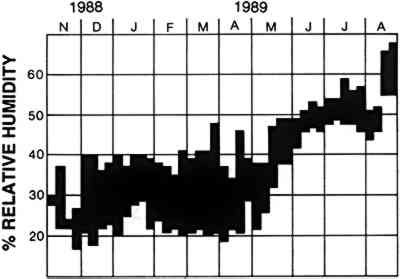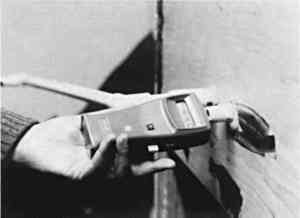THE DEVELOPMENT OF THE HUMIDITY CONTROL MODULE AT FIELD MUSEUMCATHERINE SEASE
4 EGYPTIAN EXHIBITTHREE HUMIDITY modules were used in the renovation of the Inside Ancient Egypt exhibit, which opened in November 1988. This was a much more ambitious use of these modules, as 55 cases were involved, ranging from large walk-in cases to small spaces less than 1 cu ft in volume. As these cases were spread out over 15,000 sq ft, an elaborate system of piping was needed to connect the cases to the modules. For example, polyethylene tubing was suspended from the ceiling in lengths of up to 80 ft to feed groups of cases. Conditions in this exhibit area differ from those in the Webber Resource Center discussed above. The exhibit is on the ground floor in an area where there is poor ventilation. From November 1988 through August 1989, the ambient relative humidity ranged from 17% to 70%. The average weekly fluctuation was 15.5%, while in one week the fluctuation was actually 27% (fig. 7).
The machines in this exhibit were set to maintain the relative humidity in the cases at 42%. While a lower level might normally have been chosen for Egyptian material, the level of 42% was chosen to safeguard these particular objects. Unlike the objects in Webber Resource Center, these objects were not used to a stable environment. Inside Ancient Egypt was a renovation of an exhibit put together at least 40 years ago; much of the material, in fact, had been on display since the founding of the museum in 1893. Although no records exist, there is no reason to assume that the fluctuations in the relative humidity during those years was any different from those recorded in 1988–89 mentioned above. The objects had become stable with their environment in spite of these fluctuations. The level of 42% was chosen as the midpoint between the upper and lower levels of fluctuation and the level that would cause the least harm to the objects. The relative humidity level in the cases in this exhibit were monitored using a combination of recording hygrothermographs and a Rotronic Hygroskop GT humidity and temperature probe. In the large walk-in cases, weekly recording hygrothermographs were used to provide a continuous written record of the relative humidity levels. Initially, all cases were monitored to make sure the system of piping was working and that the desired relative humidity level was reached in each exhibit case. Then, as a string of cases was attached to each machine, a case toward the end of the string was chosen for continuous monitoring. We found this system provided an accurate and cost- and labor-effective way of Many of the cases in the exhibit were either too small to accommodate recording hygrothermographs (e.g., the animal mummy niches), or the presence of hygrothermographs would have greatly disrupted the aesthetics of the case (e.g. the simulated catacombs). In these cases, relative humidity was monitored using the Rotronic probe, which required special case construction. Three-quarter inch diameter polyethylene tubes were incorporated into the construction of each case. Inside the case, the open end of the tube was positioned so that it was not visible to someone viewing the case. The other end extended out the back wall of the case into a service area and was stoppered with a plastic plug. These cases were monitored by removing the plug, inserting the probe, and recording the probe's relative humidity digital readout (fig. 8). Initially, all cases were monitored once a day at the same time, every weekday, for several weeks to ensure the system was operating properly. Thereafter, periodic readings have been taken of randomly selected cases.
Initially, these modules in the Egyptian exhibit did not perform as well as the first one in the Webber Resource Center. In fact, throughout the winter of 1988–89, it was difficult to get them to produce any humidified air at all. The reason had nothing to do with the performance of the modules themselves, but rather with the water supply. Chicago's water is hard (135–40 ppm calcium). As water evaporated in the steam generator trays to produce humidity for the system, a thick encrustation quickly built up on the trays. This encrustation forced the heating elements to work harder. When they overheated, a safety switch turned them off. At first, attempts were made to remedy this situation by cleaning the steamer trays as needed with Lime-A-Way, a proprietary bathroom cleaner containing a mixture of dilute acids. Cleaning turned out to be a time-consuming and messy job, as each tray required cleaning at least once a week. The only viable solution was to connect a deionizer to the water supply of each module. During a humidification cycle, the module required 2 1/2 gal of water per day. No source of distilled water existed within reach of the modules to provide a plumbed-in source of pure water. Using a non-plumbed-in source of water would have involved modification of the module to provide a reservoir to hold the water and considerable daily maintenance to ensure the reservoir was kept full. A deionizer connected to each module allowed the local water supply to be plumbed in, keeping maintenance to a minimum. When one of the modules was tested with a deionizer, it worked extremely well, maintaining the relative humidity in its cases at the desired level of 42 � 2%. The steam generator tray required no cleaning at all. In June 1989, deionizers were connected to all three modules in the Egyptian exhibit. They are now working quite satisfactorily, producing the desired relative humidity level of 42 � 2% in the cases. |

